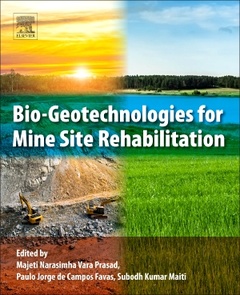Description
Bio-Geotechnologies for Mine Site Rehabilitation
Coordinators: Prasad M.N.V., de Campos Favas Paulo Jorge, Kumar Maiti Subodh
Language: English
Subjects for Bio-Geotechnologies for Mine Site Rehabilitation:
Support: Print on demand
Description
/li>Contents
/li>Readership
/li>Biography
/li>Comment
/li>
Bio-Geotechnologies for Mine Site Rehabilitation deals with the biological, physical, chemical, and engineering approaches necessary for the reclamation of mine waste. As mining has negative effects on natural resources and deteriorates the quality of the surrounding environment, this book provides coverage across different types of mining industries, which are currently creating industrial deserts overloaded with technogenic waste. The book offers cost-effective strategies and approaches for contaminated sites, along with remediation and rehabilitation methods for contaminated soils and waste dumps. It is an essential resource for students and academics, but is also ideal for applied professionals in environmental geology, mineral geologists, biotechnologists and policymakers.
Section 1 1. Abandoned Mine Reclamation – holistic approach 2. Soil Quality Indices for Evaluation of Abandoned Mine Land [AML] 3. Indicators for Monitoring Mine Site Rehabilitation 4. Biotechnological tools for remediation of Acid Mine Drainage 5. Biotechnological tools for Mine Site Rehabilitation 6. Novel methods for the remediation of Acid Mine Drainage 7. Mine site restoration using sylvicultural approach 8. Engineered soils using amendments for in situ rehabilitation of AML 9. Aided Phytostabilization of Mine Waste 10. Fly ash and lime-stabilized biosolid mixtures for mine spoil reclamation 11. Iron oxide nanoparticles and reclamation of mine sites 12. Nanoenhanced Reclamation of Mine Spoils 13. Insights and lessons learned from the long-term rehabilitation of AMLs 14. Mycoremediation for mine site rehabilitation 15. Mycorrhizal fungi from mine sites and rehabilitation of AMLs 16. Plant growth-promoting rhizobacteria-assisted phytoremediation of mine soils
Case Studies 17. Brazil -Mine Site rehabilitation in Brazil 18. China - Mine land reclamation of coal mine, A case study from China 19. Czech - Mine Rehabilitation Technologies in Czech Republic 20. India - Nyveli Lignite Mine Rehabilitation 21. Carbon sequestration and soil CO2 flux in reclaimed coal mine from India 22. Stabilization of iron ore mine spoil dump sites with vetiver system 23. India - Techniques for evaluation of mine site reclamation success 24. Ireland - Mine Sites Rehabilitation in Ireland 25. Japan – Phytorecovery of mine-impacted agricultural land in Japan 26. Artisanal and small-scale gold mining waste rehabilitation with energy crops and native flora – a case study from Nigeria 27. Poland - Reclamation of post-mining sites in Poland 28. Poland - Lignite Mine Waste reclamation 29. Russia - Biological recultivation of Ural coal mines disturbed lands 30. Russia - Mine land rehabilitation in the Russian Sub-Arctic 31. USA - Mine waste remediation in United States 32. UK: Building a Cradle for Nature: A Paradigm for Environmental Reconstruction on degraded former surface coal-mine sites in South Wales, UK 33. Thailand - Thai mining and bio-geotechnologies for sustainable development
students, academic and applied professionals in environmental geology, mineral geologists, biotechnologists, and academia, policy and decision makers
Dr De Campos Favas is a professor in the Department of Geology of the University of Trás-os-Montes e Alto Douro as well as a member of the Marine and Environmental Sciences Centre (MARE) from the University of Coimbra. He has been involved in 10 research projects. He is author and co-author of 29 peer-reviewed papers in scientific journals and 136 papers in conference proceedings, has 19 book chapters and 2 books published. His main areas of research are: heavy metals and arsenic contamination (soil, sediment, water); acid mine drainage; bioaccumulation of metals in plants (aquatic and terrestrial environments); hyperaccumulator plants; phytoremediation; bioindication; restoration of degraded mine areas.
Dr Maiti is an award winning author in Environmental Engineering. His area of focus is mining and the environment for most of his career. He has published 3 books, 89 journal papers, 14 book chapters and over 100 proceedings. He is Professor of the Department of Environmental Sc. & Engg (ESE) at the Centre of Mining Environment Indian School of Mi
- Deals with global and holistic approaches of abandoned mine land rehabilitation
- Includes mine waste rehabilitation case studies from around the world
- Covers integrated technologies, such as bioremediation of metalliferous soil
- Provide strategies for sustainable ecosystems on mine spoil dumps
- Offers novel methods for the remediation of acid mine drainage




